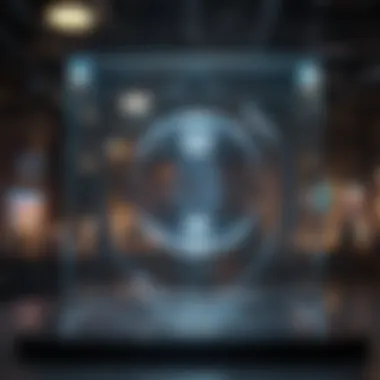Hologram Applications: Bridging Science and Technology


Intro
Hologram technology, once confined to the realms of science fiction, is now making significant inroads into various sectors. This article delves into the technical and application aspects of holography, demonstrating its relevance to contemporary science and technology. Readers will discover how holograms are changing our interaction with information and environments. Through rigorous exploration, we aim to provide clarity on the design, integration, and future potential of holographic technology.
Research Overview
Holography, fundamentally based on light interference patterns, has evolved considerably over the past few decades. This research revolves around understanding how holograms are created and utilized across different domains. The exploration involves both empirical studies and theoretical analysis, elucidating the multifaceted nature of applications.
Methodological Approaches
To better comprehend the landscape of hologram technology, multiple methodological approaches are employed. Firstly, a thorough literature review is conducted to examine existing studies and advancements in holographic techniques. Secondly, case studies are analyzed, presenting real-world applications in fields such as education, healthcare, entertainment, and corporate environments. These varied perspectives allow for an extensive understanding of both current capabilities and future possibilities.
Significance and Implications
The implications of hologram technology are vast. Its applications can enhance visual communication, improve education methodologies, and even play a role in remote surgery. Recognizing the benefits they offer helps in appreciating their importance. For instance, holography can bridge the gap between the physical and digital worlds, empowering various industries to create immersive experiences.
Current Trends in Science
Staying abreast of current trends is essential in the ever-evolving field of holography. The advancements in this sector can largely be attributed to innovative techniques and interdisciplinary collaborations.
Innovative Techniques and Tools
Recent technological developments have paved the way for more sophisticated holographic systems. The advent of digital holography has altered how we create and visualize holograms. Tools such as holographic displays and augmented reality devices are gaining traction, rendering previously difficult tasks much more feasible.
Interdisciplinary Connections
The convergence of multiple disciplines significantly influences holography. Engineers, designers, and psychologists are all contributing to this technology's advancement. For example, the integration of holograms in gaming requires knowledge of both technical engineering and human experience. Such collaborations can lead to groundbreaking innovations that might redefine how we understand and use holograms.
"The future of holography lies in its ability to adapt and evolve, becoming more integrated within our daily lives."
Prolusion to Hologram Technology
Hologram technology is a compelling field that merges art and science. It provides a unique method of capturing three-dimensional images to present visual information in an innovative way. Understanding this technology is crucial for several reasons. Firstly, it allows us to grasp the complexities behind how holograms work, which is foundational for their application in different sectors. Additionally, knowing the principles of holography can inspire further advancements in technology that may reshape industries.
Definition and Principles of Holography
Holography is more than just photographic images. It involves recording light patterns to create three-dimensional representations. When a laser beam hits an object, it reflects light waves. These waves are then captured on a medium, typically a film or a digital sensor. This process is what creates a hologram, which can be viewed from different angles, allowing the illusion of depth. The significance of this technology lies in its ability to convey information visually in a way that traditional two-dimensional images cannot.
A hologram is not simply a static image; it is a record of light fields, providing a sense of depth and realism.
Historical Development of Holography
The roots of holography trace back to the early 20th century, but the term itself was coined in 1947 by the Hungarian scientist Dennis Gabor. His initial work was theoretical, focusing on improving electron microscopy. However, it wasn't until the advent of the laser in the 1960s that practical holography was realized. The invention of lasers made it possible to produce high-quality holograms.
In the following decades, holography found applications in various fields, including entertainment, security, and data storage. Researchers began experimenting with different types of holography, such as transmission and reflection holography. These innovations allowed for a wider array of uses, creating a vibrant field of study that has continued to evolve.
Holography now finds its way into daily life, from credit cards with holographic images to complex medical imaging systems. The journey from Gabor's initial theories to today’s applications illustrates the potential of this technology to bridge gaps between visual representation and real-world applications.
Understanding Hologram Apps


Understanding hologram apps is crucial in today’s growing tech landscape. These applications fuse innovative technology and practical utility. As holograms gain traction in various sectors, it is essential to comprehend their core aspects and benefits. This knowledge facilitates better designs, improved user experience, and effective implementation.
What Constitutes a Hologram App?
A hologram app engages users through three-dimensional images. These images come alive using light interference patterns. The essence of holographic applications lies in their user interaction. Such apps can serve multiple purposes. They can be used in education, entertainment, or even health care. For instance, a hologram app can create lifelike representations of historical events in education. This could enhance learning retention for students. The user experience is integral to a hologram app's success. A misconception is that these apps are merely toys. In reality, they blend information with engagement, offering enriching experiences.
Core Technologies Powering Hologram Apps
Several technologies are essential to the functionality of hologram apps. The most prominent of these includes:
- Laser Technology: Crucial for creating holographic images. Lasers produce coherent light, permitting precise interference patterns.
- Display Technologies: Devices such as the Microsoft HoloLens or Magic Leap create immersive experiences. They project holograms in a way that integrates smoothly with real-world environments.
- Software Development Kits (SDKs): Tools like Unity or Unreal Engine empower developers to create sophisticated content. These kits streamline design and enhance visual effects.
The combination of these technologies enables seamless interaction and sophisticated imagery. As hologram technology evolves, so do the potential applications. Embracing these innovations is vital for developers and users alike. Recognizing how these components interact provides insight into the future of holographic experiences.
"Holography is not merely a technology; it is a bridge to the future of visual communication."
Through understanding these foundations, it becomes clear how essential hologram apps are in various contexts. They stand at a crossroads of science and practicality, offering glimpses of what is to come.
Key Applications in Various Sectors
Hologram technology offers a diverse array of applications across multiple sectors. The importance of exploring these applications lies in understanding how holograms influence practices and experiences in various fields. Each sector presents unique benefits derived from holographic technology, enhancing functionality and engagement in ways that traditional methods may fail to achieve.
Education and E-Learning
In education, holograms can revolutionize traditional learning methods. Holographic representations of complex topics enable students to grasp difficult concepts with greater ease. For example, anatomy students can use holograms to visualize human organs in three dimensions, providing a more detailed understanding compared to static images. Furthermore, holographic lesson plans can engage students by offering interactive experiences that a standard classroom setup cannot provide. Fostering a more stimulating learning environment leads to better retention of information and boosts creativity in problem-solving.
Health Care Innovations
In healthcare, hologram applications are making significant strides. Surgeons can employ holographic displays for pre-surgical planning, overlaying 3D models of patient anatomy directly onto the patient, allowing for better precision during operations. Additionally, medical training can benefit from Hologram simulations, enabling future healthcare professionals to practice skills in a risk-free environment. The potential reduces error rates and enhances patient safety by delivering a more immersive training experience.
Entertainment and Media
Holograms have transformed the entertainment industry by enabling lifelike representations in performances and media. For example, musicians can perform alongside holographic representations of deceased artists, creating unique collaborative experiences. Film and video game industries also integrate holograms to create stunning visual effects that immerse audiences in rich environments. The level of engagement offered by holographic content surpasses traditional media formats, captivating viewers in ways that foster deeper connections to the material.
Marketing and Advertising
In marketing, holograms represent a novel approach to advertising that captures attention effectively. Brands like Coca-Cola and Hyundai have utilized holographic displays in promotional campaigns to create memorable experiences for consumers. These interactive advertisements not only engage audiences but also help convey messages vividly. Holograms can present product features dynamically, allowing consumers to interact with products in a manner that static ads cannot achieve. This potential enhances brand visibility and drives consumer engagement.
Art and Cultural Heritage
Holograms also play an essential role in preserving and presenting art and cultural heritage. They allow museums to exhibit artifacts without the risk of deterioration. Through holographic displays, visitors can experience history in ways that traditional exhibits cannot offer. For instance, ancient sculptures can be replicated as holograms, allowing for a more accessible view of cultural heritage without compromising the integrity of the original piece. Artists are even using hologram techniques as a medium, challenging the boundaries of visual art and expanding expressive possibilities.
Hologram technology bridges the gap between science and creativity, opening up endless possibilities across various sectors.
In summary, the applications of hologram technology in education, healthcare, entertainment, marketing, and art highlight its versatility and impact. Each sector shows great promise in utilizing holographic solutions, paving the way for a future enriched by innovation and creativity.
Technical Design of Hologram Apps
The technical design of hologram applications is a vital aspect in the evolution of holographic technology. It encompasses how holograms are created, displayed, and interacted with. Each element requires careful consideration, as they work together to facilitate engaging user experiences. A well-thought-out design enhances functionality, efficiency, and overall user satisfaction.
User Interface and Experience


The user interface (UI) plays a crucial role in how users perceive and interact with holograms. An effective UI must be intuitive and accessible. It should allow users to navigate easily through holographic content. Usability testing is paramount to understanding how different users interact with the application.
Factors to consider include:
- Consistency: Icons and menus should be uniform across the application. This reduces confusion.
- Feedback: The application should provide immediate responses to user actions, reinforcing their engagement with the content.
- Accessibility: Design must accommodate users with disabilities, ensuring inclusivity.
A seamless user experience (UX) can significantly impact the overall reception of holographic applications, making the experience more engaging and effective.
Hardware Requirements for Functionality
The hardware necessary for hologram applications is diverse. Specific devices must support 3D rendering and projection. Some of the key components include:
- Display Technology: Holographic displays like Microsoft HoloLens or Google Glass are essential for visualization.
- Sensors: Motion sensors allow the application to track user movements and gestures, creating an interactive environment.
- Processing Power: Higher computational power is needed to manage complex images and real-time data processing.
These hardware components must work together harmoniously for the application to perform well. Understanding users' needs informs the choice of hardware, ensuring compatibility and effectiveness.
Software Development and Algorithms
Software development for holographic applications requires a sound understanding of algorithms related to image processing and rendering. The software must create three-dimensional representations from two-dimensional data. Key considerations include:
- Rendering Algorithms: Efficient algorithms enhance the speed at which holograms are displayed. This is critical for an immersive experience.
- Data Handling: Managing large data sets can be challenging. The software must process and present holographic data effectively.
- Integration with Existing Tech: The development process should consider how the application fits into a broader technological ecosystem. Compatibility aids in smoother implementation.
Developers must keep in mind the importance of optimization, ensuring that the application runs smoothly across varying platforms and devices.
Ultimately, a robust technical design underpins the effectiveness and sustainability of hologram applications, influencing their evolution in both practical and theoretical landscapes.
Challenges in Hologram App Development
The development of hologram applications presents several challenges that influence both their effectiveness and their widespread adoption. Understanding these challenges is essential for practitioners, researchers, and developers in the field. The primary areas of concern include technical limitations, cost implications, and user adaptability. Each of these elements plays a significant role in determining the future utility and success of hologram technology.
Technical Limitations and Solutions
The technical limitations of hologram applications stem from various factors. These limitations include resolution constraints, latency issues, and hardware requirements.
- Resolution Constraints: Holograms require high-resolution displays to provide a realistic experience. As the resolution improves, the need for high processing power increases, demanding advanced hardware.
- Latency Issues: Hologram rendering in real-time often suffers from latency, adversely impacting user experience. Minimizing latency is crucial for maintaining the illusion of reality in holographic displays.
- Hardware Requirements: Effective holography usually necessitates specialized hardware. This hardware can be expensive and may not be readily accessible for all users.
To address these challenges, developers are exploring different solutions. Emerging technologies, such as machine learning-based optimization and advanced rendering algorithms, can help improve performance and reduce latency. Additionally, advancements in display technologies are making high-resolution hardware more accessible.
Cost Implications
Developing hologram applications can be a costly endeavor. The expenses involved in research, development, and deployment can limit opportunities for many organizations.
The cost implications include:
- Research and Development Costs: Significant investment is often required to innovate in this space, including materials and workforce.
- Infrastructure Needs: Establishing an appropriate environment for testing and deploying hologram apps requires infrastructure that can be expensive.
- Consumer Adoption Costs: The price of consumer-ready devices can act as a barrier, deterring users from adopting the technology.
Efforts are being made to reduce these costs. Utilizing open-source software and hardware solutions can encourage innovation while lowering expenses. Furthermore, collaborating with educational institutions can bring down development costs by sharing resources and expertise.
User Adaptability and Acceptance


User adaptability presents another challenge to the proliferation of holographic technology. Understanding how people interact with new technology is vital for successful implementation.
Some key considerations regarding user adaptability include:
- Learning Curve: Many users may find it challenging to adapt to hologram technologies. This creates a need for educational resources and training to familiarize users with these systems.
- Cultural Reception: Different cultures may perceive hologram technology differently, affecting its acceptance. Understanding these cultural contexts is essential for the technology's acceptance.
- Usability Concerns: If hologram applications are not intuitive, user frustration may arise. A focus on user-friendly design can mitigate such issues.
To encourage user acceptance, developers should prioritize comprehensive training programs and support systems. Ensuring that holographic applications are user-friendly can facilitate better adaptability.
"Addressing these challenges is crucial for unlocking the full potential of holographic technology. Continuous research, user feedback, and collaboration can lead to significant advancements in this field."
In summary, while the challenges in hologram app development are significant, they are not insurmountable. Technical limitations can be overcome with innovation, and cost implications can be managed through strategic planning. Finally, a focus on user experience will be fundamental to ensure that society can fully leverage the advantages provided by holography.
Future Prospects of Hologram Technology
The discussion on future prospects of hologram technology is crucial in understanding how these tools will shape various sectors in the upcoming years. Holograms have the potential to redefine how we interact with digital content and each other. As the technology advances, we can expect richer visual experiences and innovative applications that extend beyond current limitations.
Innovative Use Cases on the Horizon
Future use cases for hologram technology are diverse. One promising area is in remote collaboration. As businesses embrace remote work, holographic tools can create a more immersive environment for virtual meetings. Participants may feel present in a shared space, enhancing engagement and interaction.
Another avenue is in retail. Imagine shopping online with holographs displaying products in real time, allowing customers to visualize items in their own environment. Brands like IKEA have already explored augmented reality, and holograms could elevate this experience further.
In the realm of education, educators can utilize holograms to teach complex concepts interactively. For example, biology classes might feature a life-size hologram of human anatomy, allowing students to explore the subject in detail. This approach can significantly improve retention and understanding.
Furthermore, entertainment industries could leverage holograms for live performances. Artists could appear as holographic projections, allowing for concerts that combine physical and digital elements. These new experiences can take the audience engagement to a whole new level.
Potential Influence on Society
The influence of hologram technology on society may be profound. It has the potential to affect communication patterns, notably in enhancing how humans connect. With holographic displays in homes and offices, traditional meetings might become obsolete. Instead, individuals could share a 3D space despite being miles apart, thus fostering deeper relationships.
Moreover, the integration of holograms in daily life raises ethical questions. Issues surrounding privacy and security are paramount. As personal data becomes increasingly essential for these technologies, regulations must evolve to protect users. Balancing innovation with safety will be vital to avoid potential misuse of holographic data.
"The future of holographic technology hinges on a balance between innovation and ethical considerations in its applications."
Finally, societal impacts can also spread beyond individual technology users. Industries dependent on logistics and manufacturing may transform due to holographic interfaces that streamline processes and reduce costs. Holograms can enhance training methodologies, lead to better scenarios, and make skill acquisition more practical.
Closure
The conclusion of this article synthesizes the extensive exploration of hologram applications. Hologram technology represents a convergence of innovative approaches across various sectors, demonstrating its increasing significance in modern society. Understanding the potential of halogram apps helps us appreciate their technical framework and the many ways they interconnect with academic, medical, and commercial fields.
Summarizing Key Insights
Throughout this article, we have identified several crucial points regarding hologram applications. These insights include:
- Diverse Applications: Holograms are being used in education, healthcare, entertainment, marketing, and cultural heritage.
- Core Technologies: Technologies such as augmented reality and virtual reality are pivotal in the design and functioning of hologram apps.
- Challenges & Solutions: The discussion outlined several challenges, including technical limitations and user adaptability, which require strategic approaches to overcome.
- Future Prospects: Many innovative use cases are emerging, suggesting that hologram technology will significantly influence various sectors in the coming years.
The realization of these insights emphasizes the value of continued research and development in holographic technology. A comprehensive understanding of these elements assists stakeholders in making informed decisions about the integration and adoption of hologram applications in practical scenarios.
Final Thoughts on Hologram Applications
Hologram technology stands at the threshold of several transformative possibilities. As researchers, educators, and industry professionals delve deeper into its mechanisms, we can expect more enhanced applications. Issues such as cost implications, usability, and technical barriers remain pertinent but can be addressed through collaboration among disciplines.
Investing in the future of holographic technology not only pushes the boundaries of what we see and experience but also redefines interaction dynamics across sectors.
"The technology may not be perfect today, but the foundations laid will reshape our understanding of information and experience in the near future."
In summary, hologram applications are not merely technological novelties; they are instruments of change that foster interdisciplinary collaboration and innovation. The journey into holography provides more than insights; it opens doors to uncharted territories in human capability and social interaction.



